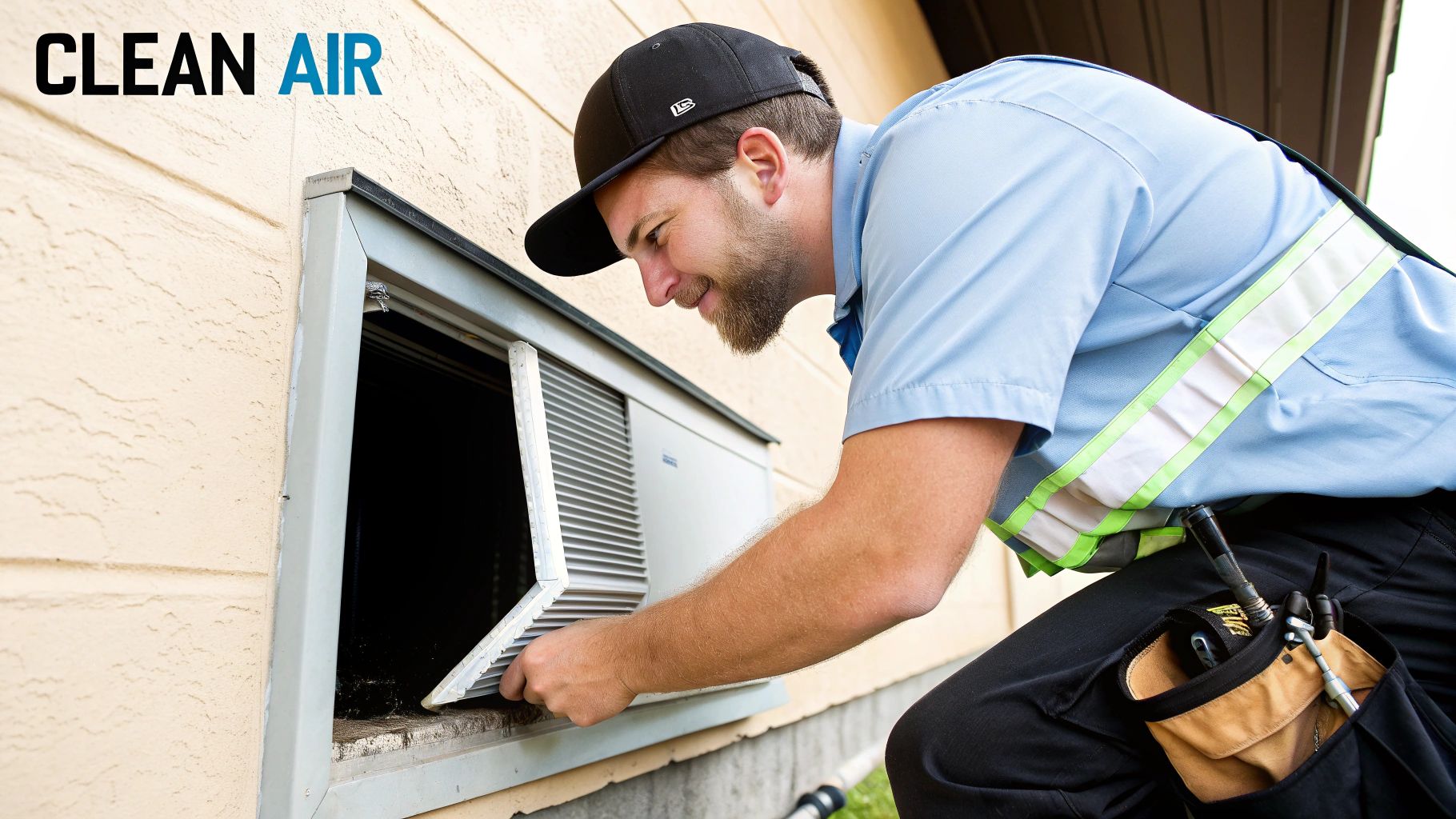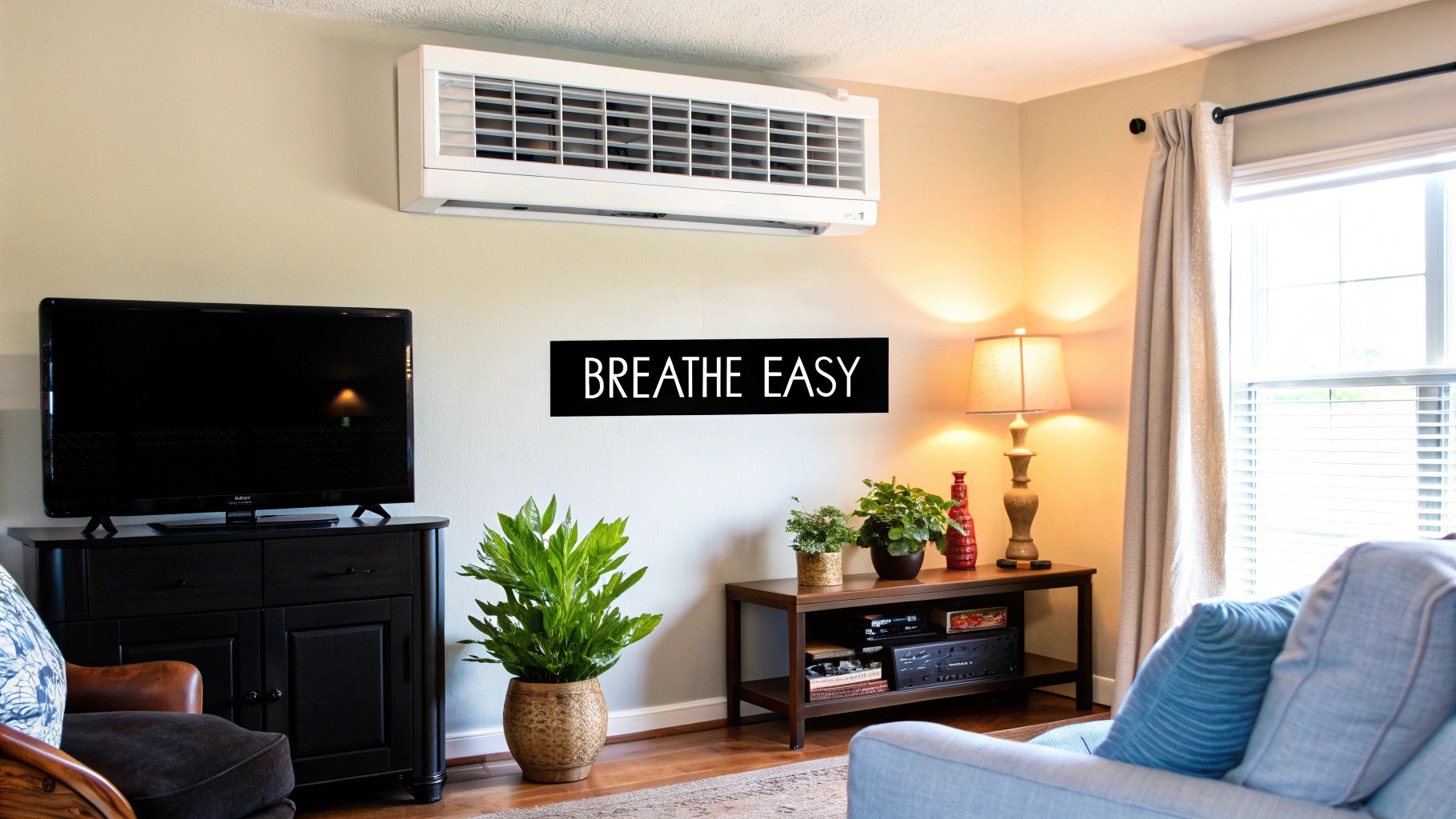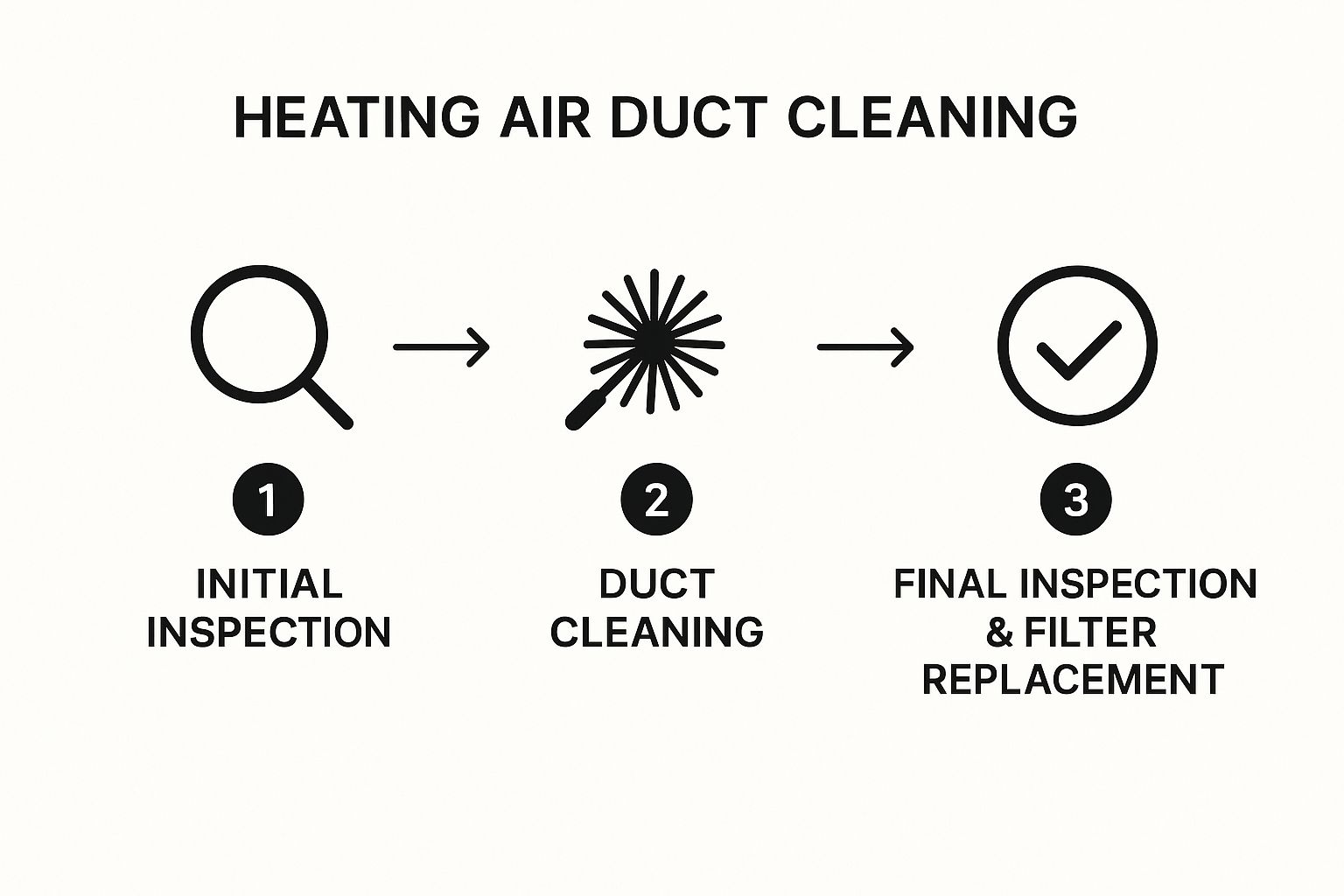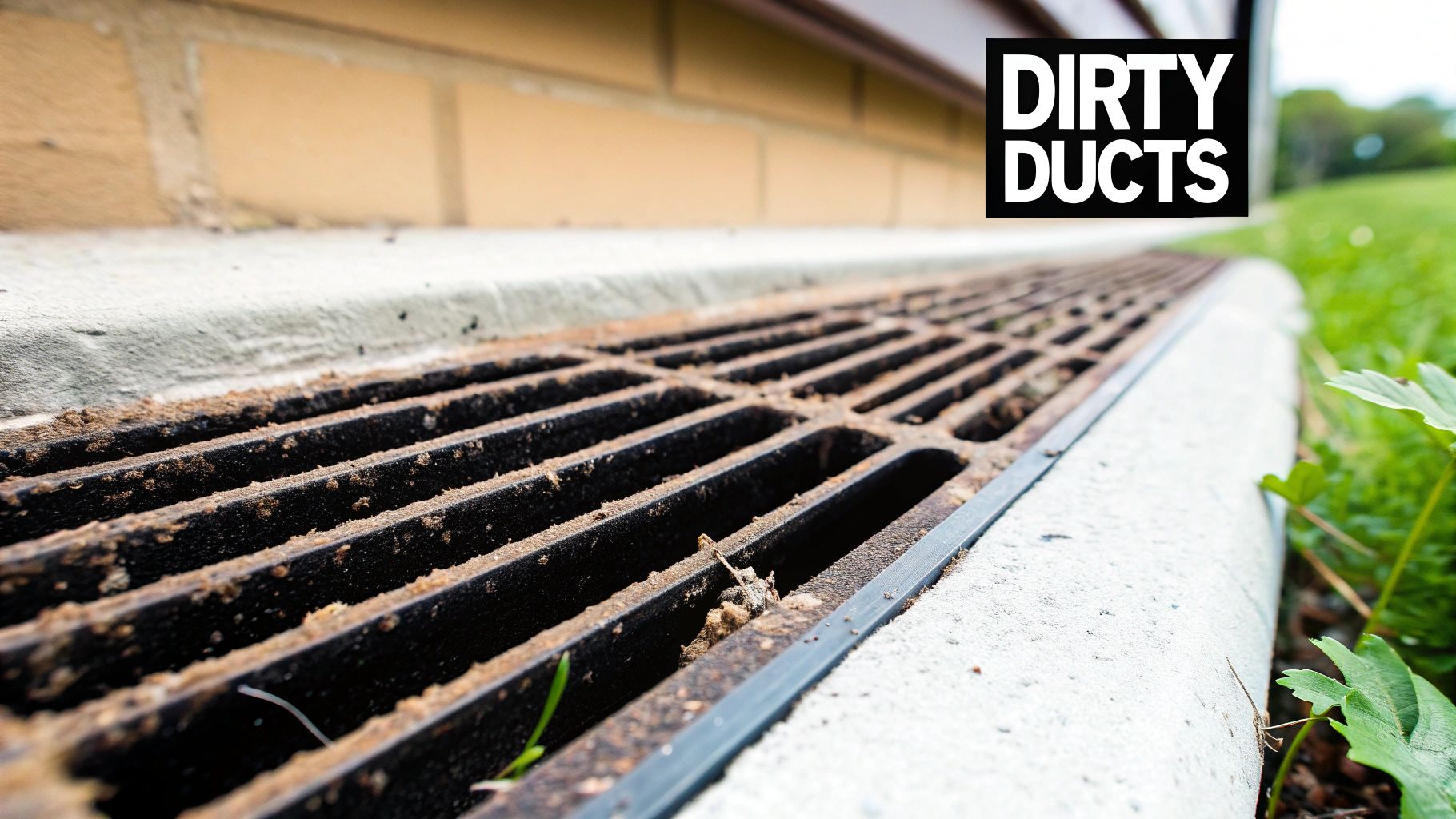Heating air duct cleaning is all about using powerful, specialized equipment—think high-powered vacuums and tools that agitate grime—to pull out all the built-up dust, debris, and other gunk from your home's forced-air system. It’s a smart move for improving your indoor air quality and boosting your HVAC's efficiency, especially if you're dealing with endless dust or nagging allergy symptoms.
Why Clean Heating Ducts Actually Matter

It’s easy to write off duct cleaning. Let's be honest, it's a classic "out of sight, out of mind" part of home maintenance. But that hidden maze of ducts delivering warm air throughout your house is also the perfect place for everything you don't want to be breathing in.
Think of it as your home’s respiratory system. It's constantly circulating air, and over time, it collects a shocking amount of stuff. Especially for those of us in colder climates like the Greater Toronto Area, where our furnaces are working overtime for months, the buildup can be pretty intense. That constant airflow acts like a conveyor belt, dropping off layers of dust, pet dander, pollen, and other allergens deep inside the ductwork.
The Impact on Air Quality and Health
The real issue isn't just a bit of dust; it’s what's hiding inside it. These microscopic contaminants can cause big problems, particularly for kids, the elderly, or anyone with sensitivities. They can trigger ongoing respiratory issues without you ever pinpointing the source.
Here’s a look at what we typically find lurking in residential ductwork:
- Allergens: This is the big one. Pet dander, pollen, and dust mites are common culprits that can make life miserable for anyone with allergies or asthma.
- Mould and Mildew: If any moisture has ever gotten into your system—even from a minor leak years ago—mould spores can take hold and get blown all over your house.
- Bacteria and Viruses: Airborne germs love to settle and multiply in the dusty, dark environment of an uncleaned duct system.
By getting rid of these contaminants right at the source, professional heating air duct cleaning seriously cuts down on the number of irritants floating around your home. This often brings noticeable relief for family members with respiratory conditions and creates a much fresher, healthier indoor environment for everyone.
HVAC Efficiency and Longevity
Beyond the air you breathe, dirty ducts make your entire HVAC system struggle. When ducts and filters are clogged, it’s like trying to breathe through a straw. Airflow is restricted, forcing your furnace to run longer and burn more energy just to push heated air through the congested pathways. This, of course, leads to higher utility bills.
That constant strain also puts extra wear and tear on important parts like the blower motor and heat exchanger. To really see how this service can transform your home's air, you can learn more about the benefits of air duct cleaning and its impact on your system's lifespan.
Of course, maintaining a healthier home goes beyond just the ducts. It’s part of a bigger picture. For a more complete strategy, you might want to look into effective cleaning and disinfecting methods for a safer home to round out your efforts.
Telltale Signs Your Ducts Need Cleaning

It can be tough to tell when your ducts have gone from a little dusty to genuinely dirty. After all, they're hidden behind walls and ceilings. But you don't have to guess. There are some clear, tangible clues that it’s time for a professional heating air duct cleaning.
The most obvious red flag? A sudden explosion of dust around your house. If you feel like you’re constantly wiping down furniture, electronics, and countertops more than usual, your ductwork is the likely culprit. A clean HVAC system shouldn't be blasting visible dust particles from the vents every time the heat kicks on.
Go take a quick look at your vent covers, too. See a noticeable layer of dust, pet hair, or fuzzy grey gunk clinging to the grilles? That's a clear sign of what’s building up deeper inside. Think of it as the tip of the iceberg—it’s just a fraction of the debris that's actually circulating through your home's airway.
Life Events That Demand a Duct Check
Some situations are an automatic trigger for at least getting your ducts inspected.
Moving into a new-to-you home is a big one. You have absolutely no idea when—or if—the previous owners ever had the ducts cleaned. It's so much better to start with a clean slate than to inherit years of someone else's accumulated dust, dander, and who knows what else.
Another critical time is right after a major home renovation. That fine drywall dust, sawdust, and other construction debris are experts at finding their way into your return vents and settling throughout the entire system. If you run your furnace without cleaning them out first, you’re just spreading that mess everywhere.
Think of it this way: if the air in your home feels persistently stuffy, or if musty odours appear whenever the HVAC system starts running, your ducts are likely harbouring the source of the problem. This isn't just about dust; it's about eliminating the source of poor indoor air quality.
When Allergies and Efficiency Suffer
Sometimes the signs are less about what you can see and more about how you and your family feel. Has there been a sudden spike in allergy or asthma symptoms that you can't blame on the season? Your ductwork could be the problem. Every time the furnace runs, it's recirculating mould spores, dust mites, and pet dander that have been building up for years.
Finally, take a look at your energy bills and your system's performance. Ducts clogged with debris restrict airflow, forcing your furnace and air conditioner to work much harder and longer to keep you comfortable. If you've noticed weaker airflow from certain vents or your utility bills are creeping up for no good reason, a congested duct system is a very likely cause.
To help you put it all together, here’s a quick reference table.
When to Consider Professional Air Duct Cleaning
| Observable Sign | What It Means for Your Home | Next Steps to Consider |
|---|---|---|
| Visible Dust from Vents | Your system is actively circulating dust and debris throughout your living space. | Perform a visual check of vents and change your furnace filter. If dust persists, it's time to call a pro. |
| Excessive Household Dust | The ductwork is likely saturated with so much debris that it can no longer contain it. | Increase dusting frequency temporarily and schedule a professional duct inspection. |
| Musty or Stale Odours | Mould, mildew, or decomposing pests could be trapped inside the ducts. | Rule out other sources of odours (e.g., drains, carpets) and then get a camera inspection of the ducts. |
| Increased Allergy Symptoms | Allergens like pollen, dander, and dust mites are being recirculated instead of filtered out. | Upgrade to a higher-MERV furnace filter and consider a professional cleaning to remove the source. |
| Poor Airflow | Blockages are restricting the flow of heated or cooled air, reducing system efficiency. | Check that all vents are open and unobstructed. If airflow is still weak, the ducts need clearing. |
If you're nodding along to a few of these points, it's probably time to act. You can always explore other common signs that you need to get your air ducts cleaned to be absolutely sure before picking up the phone.
The Professional Cleaning Process Uncovered
When a professional heating air duct cleaning crew shows up, you can expect a lot more than someone just sticking a vacuum hose into your vents. It’s a methodical, multi-step process designed to pull years of gunk out of your system without leaving a dusty mess all over your house. Knowing what a quality job looks like helps you appreciate the value and spot a pro from an amateur.
The entire service hinges on one crucial concept: containment. The whole point is to knock all the dust, pet dander, and other debris loose from deep inside the ductwork and suck it out immediately, making sure none of it escapes into your living space. This is where professional-grade equipment really shines.
Creating Negative Pressure: The Key First Move
Before any scrubbing or brushing starts, the technicians hook up a massive, powerful vacuum collection unit to your main duct lines, usually right by the furnace. This isn't a shop vac; it's a beast of a machine, often mounted in their truck and connected with a huge hose.
Once they fire it up, your entire duct system is put under negative air pressure. Picture a powerful, one-way wind tunnel running through your vents. Any particle that gets stirred up has only one direction to go: straight out of the house and into the collection unit. This is the absolute non-negotiable first step for any legitimate service. It’s what prevents dust from getting blown from one room into another.
At the same time, the crew will go through your home and seal every single supply and return vent with adhesive covers. This isolates the whole network, which really ramps up the suction power and stops any nasty blowback into your rooms while they're working.
This infographic gives you a quick visual on the main stages of the cleaning process.

As you can see, a true professional service is a systematic journey, moving from a thorough inspection to the deep clean, and finishing with a final quality check.
Agitation Tools: Waking Up the Debris
With the system under constant suction, the real cleaning begins. Technicians move through your house, unsealing one vent at a time to concentrate their efforts on a single duct run. They feed specialized agitation tools down the ductwork to break loose all the stubborn, caked-on grime from the inside surfaces.
We're not talking about household cleaning tools here. This gear is specifically designed to navigate the twists and turns of your ductwork without causing damage.
- Rotary Brushes: Think of these as powerful scrubbing brushes on the end of long, flexible cables that scour the inside walls of your ducts.
- Air Whips: These are high-pressure air tools with whip-like ends that thrash around inside the duct, knocking debris loose from every nook and cranny.
- Skipper Balls: These little tools shoot concentrated jets of compressed air in all directions, essentially power-washing the duct surfaces with air.
As these tools work their magic, all that dislodged gunk is immediately pulled down the line by the negative pressure and captured in the truck-mounted unit. It’s this one-two punch of agitation and powerful suction that makes professional heating air duct cleaning so incredibly effective.
Here's a pro tip: A key sign of a thorough job is watching the technicians clean each duct run individually, all the way from the vent back to the main trunk line. A "blow-and-go" service that just vacuums the opening of the vent is going to miss most of the contaminants hiding deeper in the system.
Final Checks and System Components
After every single supply and return duct has been cleaned, the crew turns its attention to the core components of your HVAC system. They’ll clean the blower motor, its housing, and the fan assembly, since these parts get caked with dust and hurt your system's efficiency. They'll also clean accessible parts of the heat exchanger and the A/C coil.
Technology is always pushing the industry forward. For instance, the heating and air duct cleaning world is changing fast, especially as people become more aware of indoor air quality. We're expecting to see robotics and AI-assisted devices become more common by 2025, allowing for even more precise cleaning of complex systems with live camera feeds and better particle capture. This lines up with standards from groups like the National Air Duct Cleaners Association (NADCA), ensuring top-tier service.
To wrap things up, the crew does a final inspection, sometimes with a camera, so you can see the before-and-after difference for yourself. They’ll remove all the seals, put your vent covers back on, and pop in a fresh, clean furnace filter—a vital last step to keep your newly cleaned system pristine. For a deeper dive into the equipment and methods, our guide on the air duct cleaning process has even more detail.
Understanding Air Duct Cleaning Costs

Let's talk money. When it comes to professional heating air duct cleaning, the price tag is usually the first thing homeowners ask about. The truth is, there's no single, flat rate for this kind of work. The cost is unique to your home, and knowing what drives the price will help you budget properly and avoid those too-good-to-be-true deals.
The biggest factor influencing the cost is the size of your home and the complexity of your ductwork. A sprawling bungalow with dozens of vents is a different job than a small two-story townhouse. It all comes down to the time, labour, and equipment needed to do the job right. Accessibility matters, too—a system tucked away in a cramped crawl space will almost always cost more to service than one in an open, easy-to-reach basement.
What Influences the Final Quote
Beyond the square footage, the condition and type of your ducts play a big part. For instance, flexible ductwork requires a more delicate touch and different tools than standard rigid metal ducts, which can affect the quote.
A reputable company will always look at these key details before giving you a final price:
- Number of Vents: The more supply and return registers you have, the longer the job takes. Simple as that.
- System Contamination: If your ducts are full of construction debris, dealing with mould, or have become a home for pests, the cleaning process becomes much more intensive.
- Accessibility of Ductwork: Hard-to-reach areas mean more labour and time, which will be reflected in the cost.
- HVAC System Size: The size of your furnace and the main trunk lines that connect everything also play a role in the final price.
For homeowners in California, you can generally expect to pay somewhere between $350 and $600 for a professional cleaning. Of course, for very large homes or those with serious contamination issues, that price can climb upwards of $1,200. This wide range is pretty typical across North America and really highlights how much your home’s specific needs matter.
Spotting Red Flags in Pricing
If there’s one thing to take away from this, it’s to be skeptical of the rock-bottom price. We've all seen those flyers advertising a whole-house cleaning for a ridiculously low price, like $99. These are almost always a bait-and-switch.
A price that seems too good to be true almost always is. These lowball offers often lead to an incomplete job where only the vent openings are vacuumed, or the company will pressure you into expensive, unnecessary add-ons once they're in your home.
A fair quote reflects the hours of skilled labour and the use of powerful, truck-mounted equipment needed for a thorough cleaning. Always insist on a detailed, written estimate that breaks down exactly what's included. This lets you compare quotes accurately and make a smart investment in your home's air quality.
To get a better handle on what to expect, check out our guide on how much for duct cleaning to arm yourself with the right info before you get a quote.
How to Hire a Reputable Cleaning Company
Choosing the right company for your heating air duct cleaning is just as important as the cleaning itself. Let's be honest, making the wrong choice can lead to a world of headaches—from damaged ductwork and a filthy house to an incomplete job that leaves all the nasty stuff behind. The goal is to find a genuine professional, not just the guy with the cheapest flyer.
So, where do you start? A solid first step is to look for companies with proper industry certifications. The National Air Duct Cleaners Association (NADCA) is the gold standard here. A NADCA-certified company means they play by the rules, following strict standards and ethics. It’s your assurance that their technicians actually know how to clean your system safely and thoroughly.
Don’t be afraid to ask for their certification when you call for a quote. A pro will be proud to show it.
Vetting Potential Companies
Beyond a fancy certificate, you need to make sure the company is fully insured, covering both liability and workers' compensation. This is non-negotiable. It protects you from any "what if" scenarios, like accidental damage to your property or an injury on the job. Any reputable company will have no problem sending you their certificate of insurance.
Once you’ve handled the official stuff, it’s time to do a little digging into their reputation. Online reviews are a good starting point, but you have to learn how to read between the lines. Look for detailed reviews that talk about the actual process, the crew’s professionalism, and the final results.
One bad review isn't necessarily a dealbreaker, but a clear pattern of complaints about pushy upselling or sloppy service is a massive red flag.
Remember, the cheapest price is almost never the best value. Those rock-bottom quotes are often a classic bait-and-switch tactic. They lure you in with a price that seems too good to be true, and once they're in your home, they pressure you into expensive "add-ons" you don't actually need. Be sure you know the common duct cleaning scams to protect yourself.
Key Questions to Ask Before You Book
Once you have a shortlist of two or three companies, give them a call. How they handle your questions will tell you a lot about their business.
- What kind of equipment do you use? You want to hear them mention powerful truck-mounted vacuums and negative air pressure systems. This isn’t a job for a Shop-Vac.
- Can you walk me through your cleaning process? A thorough answer should include sealing the vents, using agitation tools inside the ducts, and cleaning the entire system—including the often-forgotten blower motor.
- Is your quote all-inclusive? Always ask for a written, itemized estimate. This little step helps you avoid any nasty surprise charges on the final bill.
Knowing how to properly vet a professional is a crucial skill for any homeowner, whether it's for duct cleaning or any other service. You can find some great general advice in these essential tips for finding the right home service professional. Taking the time to ask the right questions ensures you hire a true expert who will leave your home’s air cleaner and healthier.
Common Questions About Duct Cleaning Answered
Even after getting the rundown on the whole process, it's totally normal to have a few more questions rattling around before you pick up the phone. We've put together answers to the most common queries we get from homeowners, so you can feel completely confident about your decision.
How Long Does Professional Duct Cleaning Usually Take?
For a typical home in the Toronto area, you're usually looking at a timeframe of 3 to 5 hours. That's just a ballpark figure, of course.
The actual time on-site can change based on a few things: the size of your house, how many vents you have, and how easy it is for the crew to get to the ductwork. The amount of gunk built up in there also plays a big role. Any good company will give you a much more solid time estimate after they've had a chance to ask about your home’s specifics.
Will The Cleaning Process Make My House Dusty?
This is probably the number one worry we hear, but the answer is a hard no—as long as you've hired true professionals. They use massive, truck-mounted vacuums that put your entire duct system under negative pressure.
This is the key. That powerful suction means any dust, debris, or allergens that get knocked loose are immediately pulled out of your vents and straight into a containment unit on the truck. To be extra sure, technicians also seal off every register as they work, making it impossible for particles to sneak back into your living space.
A hallmark of a reputable company is that they leave your home just as clean as they found it, if not cleaner. If a crew can't promise a dust-free job, it’s a massive red flag that they don't have the right gear.
Can I Just Clean The Ducts Myself?
Look, wiping down your vent covers and sticking a vacuum hose as far as it can go is great for regular upkeep. But it doesn't even come close to what a professional service can do. The real nastiness is lodged deep inside the system, often caked on after years of buildup.
Getting to that deep-seated grime requires specialized tools like high-powered air whips and long rotary brushes—stuff you just can't rent at the local hardware store. Trying to DIY a deep clean can often just shove the dirt further down the line or, even worse, you could end up damaging the ductwork itself.
Are The Chemicals Used For Cleaning Safe?
For a standard heating air duct cleaning, the process is entirely mechanical. It’s all about powerful brushes and suction, no chemicals required. This physical agitation is more than enough to get rid of everyday dust and debris.
Now, if the inspection turns up something more serious like mould, mildew, or bacterial growth, the technician might suggest using an EPA-approved antimicrobial sanitizer. A transparent, trustworthy company will always discuss this with you first. They'll tell you exactly what product they recommend, provide its safety info, and only use solutions proven to be safe for your family and pets once properly applied and dried.
Ready to breathe cleaner, healthier air in your home? The experienced team at Can Do Duct Cleaning is here to help. With over 30 years of dedicated service in the Greater Toronto Area, we use state-of-the-art equipment and eco-friendly methods to ensure your ducts are impeccably clean. https://www.candoductcleaning.com


